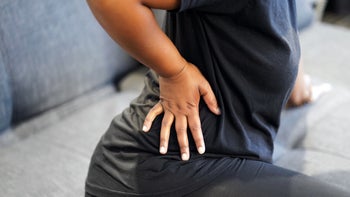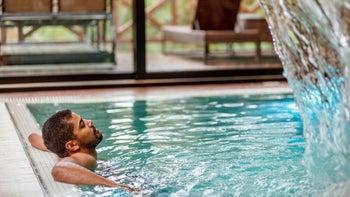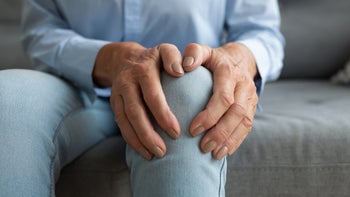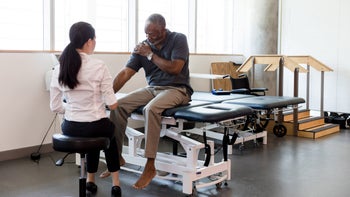
8 Water Exercises That Are Easy on Your Joints
Key takeaways:
Water exercises are a low-impact way to increase strength, flexibility, and cardiovascular fitness.
Water-based exercises can help you meet your fitness goals without putting too much stress on your joints.
If you have arthritis or other joint conditions, exercising in water may help you manage joint pain and stiffness.

Swimming is just one of the many water exercises you can do to boost your health and fitness. These types of exercises provide low-impact workouts that are easy on your joints. And you can tailor them to your abilities. So you don't have to be a champion swimmer to enjoy the health benefits.
Which water exercises are easiest on your joints?
In general, all water exercise is easy on the joints and provides a low-impact, full-body workout. Typically, you do aquatic workouts in a shallow pool that’s about 3 to 5 feet deep. The water’s buoyancy helps support your weight, making it easier to move than when you exercise on land.
Water also exerts hydrostatic pressure on objects, which creates resistance against your body as you move. So pool workouts are gentle yet effective activities.
Save over 40% on Qsymia with GoodRx
Discover the once daily Qsymia for weight management. Qsymia is for adults and children 12-17 in combination with a healthy diet and regular exercise.

Whether you want to improve your overall fitness or target upper- or lower-body muscles, the eight joint-friendly water exercises outlined below can help. Try to complete 1 to 3 sets of 10 to 15 repetitions for each move. But don’t be afraid to adjust this target to fit your goals and abilities.
1. Lateral arm raises
Lateral arm raises can increase shoulder muscle strength and flexibility. You use dumbbells when you do traditional lateral or side arm raises. But this water version can be done equipment-free or with foam dumbbells to increase the intensity.
Stand upright in shoulder-deep water with your arms at your sides.
Raise your arms up and out to the sides until they are at shoulder level but not breaking the water’s surface. Your palms should be facing down.
Hold briefly and then lower your arms to the starting position.
2. Hand flutters
Hand flutters target your biceps and forearms to help you strengthen and tone your arms.
Stand in chest-deep water with your feet together, knees soft, and arms at your sides.
Tuck your elbows at your sides, and then bend your arms to a 90-degree angle. Your palms can face up or down just beneath the surface of the water.
Lower your right hand to your thigh, and then re-bend your elbow and lift your hand back to the water’s surface as fast as possible. Repeat this fluttering motion with your left arm.
Continue alternating between your right and left arms at a steady pace.
3. Side steps
Side steps are a simple yet effective way to improve your agility. You can also use resistance bands around your legs during this exercise to enhance strength and flexibility in your hip abductors. These muscles allow you to move your legs to the side.
Stand upright in chest-deep water, facing the pool wall.
Take one step to the side with your right foot, keeping your legs straight and your knees soft.
Step your left foot to meet your right foot.
Repeat this movement, taking 10 to 20 side steps to the right.
Switch to your left leg and repeat steps two through four.
Complete the sequence twice in each direction.
Read more like this
Explore these related articles, suggested for readers like you.
4. Standing knee lifts
This move works your thigh, hip, and core muscles. And it’s a great way to warm up your lower body before more rigorous moves like lunges or squats. To up the intensity of standing knee lifts, you can increase your speed or add ankle weights.
Stand up tall in chest-deep water. (Hold onto the pool’s edge if you need extra support.)
Squeeze your abs to engage your core.
Lift your right knee toward your waist, creating a 90-degree angle at the hips.
Lower your leg and return to the starting position.
Repeat with your left leg.
5. Lunges
This compound exercise engages multiple muscles, including your abs, hips, glutes, and legs. And doing forward lunges in water is a more gentle way to do the exercise, which can help you avoid potential pain.
Stand near the pool wall in waist-deep water.
Face the wall with your feet together and your hands on your hips.
Engage your core and take a big step forward with your right leg. Your heel should hit the pool floor first.
Lower your hips toward the pool floor as you sink into the lunge. Your right thigh should be parallel to the floor. But make sure your right knee doesn’t float forward past your toes.
Press into your right foot to push up and return your leg to the starting position.
Repeat with your left leg.
6. Water walking
Walking in water works your arms, legs, and core, making it a total-body exercise. And you can use handheld floatation equipment to make the workout more intense.
Start in waist-deep water with your back straight, feet firmly on the pool floor, and your weight evenly distributed.
Engage your core and take one step forward, letting your arms swing naturally.
Focus on your posture as you continue walking for roughly 5 minutes.
7. Jumping jacks
Jumping jacks are a plyometric exercise, meaning it requires you to use your muscles at high speed and force. Jumping jacks provide a full-body workout that can improve strength, coordination, and flexibility. And doing them in water reduces the impact on your joints.
Stand in chest-deep water with your feet together and arms at your sides.
Jump while pushing your legs out to the sides, until they are shoulder-width apart. At the same time, swing your arms out to the sides and overhead.
Jump again, bringing your feet back together and your arms back to your sides as you land.
Repeat the full movement.
8. Squat jumps
Squat jumps are another plyometric move, but they specifically target the lower body, including your hips, legs, and glutes. And there are variations that allow you to adjust the intensity based on your fitness level.
Start in chest- or waist-deep water with your feet shoulder-width apart.
Bend your knees, lowering into a full squat. And bend your elbows, holding your hands toward each other in front of your chest.
Engage your core and jump as you extend your arms straight down toward the pool floor.
Return to the starting position and repeat.
What water safety tips should you consider before doing water exercises?
Before you begin a water-based exercise program, keep these water-safety tips in mind:
Talk to your healthcare provider about whether it’s safe for you to do a water-exercise routine.
Get familiar with the pool before entering the water, noting different pool depths and entry and exit points.
Exercise with a qualified instructor, with a buddy, or when a lifeguard is on duty.
Wear water shoes to reduce stress on your joints and prevent injury.
Consider using a buoyancy belt or other floatation device, especially if you’re not an experienced swimmer or don’t typically practice deep-water exercise.
Be careful when walking on the deck and when entering and exiting the pool, as surfaces may be slippery.
Drink plenty of water to stay hydrated.
Although you don't need any equipment to exercise in water, there are some items that can help you increase your workout intensity. These include:
Foam dumbbells
Webbed resistance gloves
Wrist and ankle weights
Resistance bands
What are the benefits of water exercise?
Water exercise offers numerous health benefits for people of all ages and fitness levels. It can help improve cardiovascular fitness, muscle strength, and flexibility. And, because it’s low impact, it’s especially beneficial for older adults and people with conditions that affect the joints, such as arthritis.
Exercising in water can:
Improve symptoms in people with chronic conditions like fibromyalgia, multiple sclerosis, and diabetes
Increase mobility and decrease pain in joints affected by arthritis
Reduce low back pain
Improve mental health and reduce anxiety
Help people manage or lose weight
Maintain or improve bone health in post-menopausal women
Enhance older adults’ quality of life
The bottom line
Aquatic exercises can build strength, flexibility, and endurance. Because water creates buoyancy, which helps support your body weight, these workouts are gentle on your joints. That support, coupled with the water’s resistance, means pool exercises offer low-impact, effective training methods.
As with any workout routine, you should consult your healthcare provider before beginning a water-exercise program.
Why trust our experts?



References
American Council on Exercise. (n.d.). Forward lunge.
American Council on Exercise. (n.d.). Lateral raise.
Aqua-Exercises.com. (2022). Squat exercises in the pool.
Aquatic Exercise Association. (2020). Aquatic fitness programming: Standards and guidelines.
Barbosa, T. M., et al. (2009). Physiological assessment of head-out aquatic exercises in healthy subjects: A qualitative review. Journal of Sports Science & Medicine.
Bento, P. C. B., et al. (2012). The effects of a water-based exercise program on strength and functionality of older adults. Journal of Aging and Physical Activity.
Berry, J. W., et al. (2015). Resisted side stepping: The effect of posture on hip abductor muscle activation. Journal of Orthopedic & Sports Physical Therapy.
Centers for Disease Control and Prevention. (2022). Health benefits of swimming.
Ecklund, C. (n.d.). Plyometrics: Developing power with plyometric exercises. NASM.
Faíl, L. B., et al. (2021). Benefits of aquatic exercise in adults with and without chronic disease – A systematic review with meta-analysis. Scandinavian Journal of Medicine & Science in Sports.
Kauffman, B. E., et al. (2014). Aquatic therapy. A Comprehensive Guide to Geriatric Rehabilitation.
Mansfield, P. J., et al. (2019). Structure and function of the hip. Essentials of Kinesiology for the Physical Therapist Assistant.
National Multiple Sclerosis Society. (2016). Aquatic exercise programming for people with multiple sclerosis.
Oral, O., et al. (2021). Effects of aquatic exercise in the treatment of obesity. Journal of Scientific & Technical Research.
Peng, M., et al. (2022). Efficacy of therapeutic aquatic exercise vs physical therapy modalities for patients with chronic low back pain. JAMA Network Open.
Sato, D., et al. (2007). The water exercise improves health-related quality of life of frail elderly people at day service facility. Quality of Life Research.
Simas, V., et al. (2017). Effects of water-based exercise on bone health of middle-aged and older adults: A systematic review and meta-analysis. Open Access Journal of Sports Medicine.
Swimming.org. (n.d.). Hand flutters.
UC San Diego Health. (2022). Exercises to increase agility: Side steps.




























